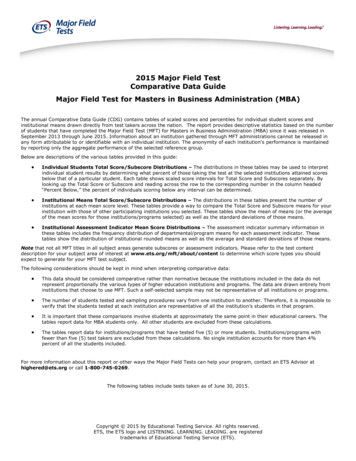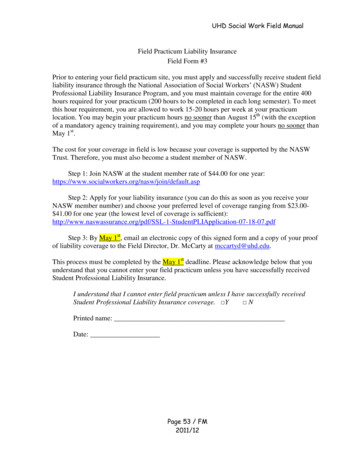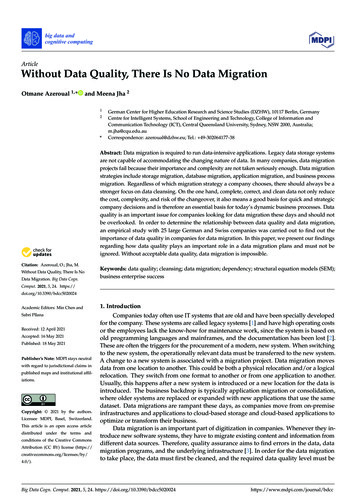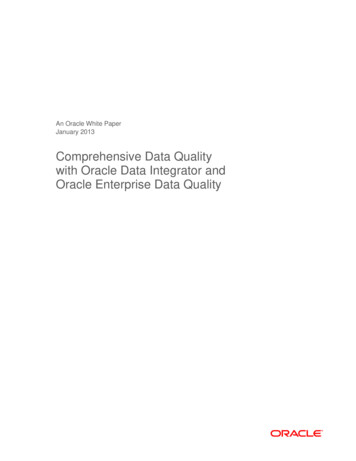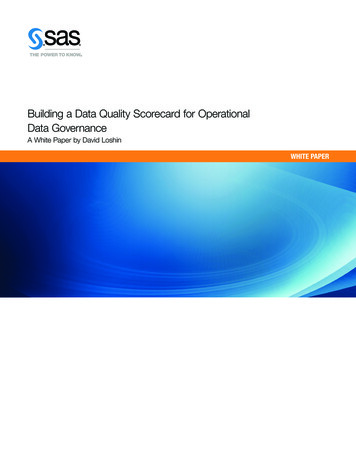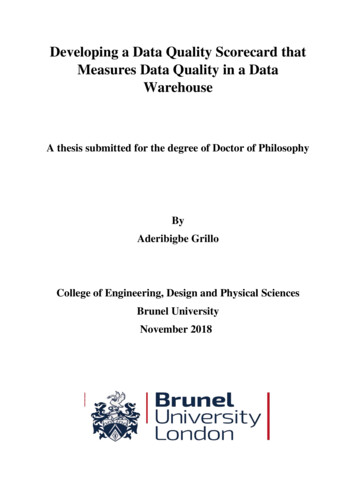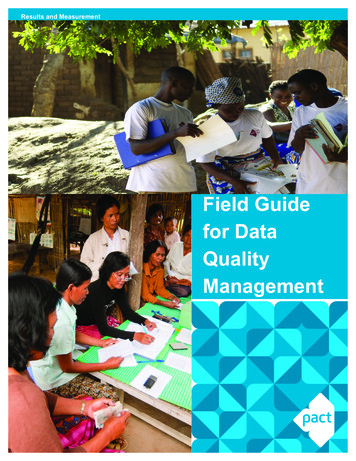
Transcription
Results and MeasurementField Guidefor DataQualityManagement
Field Guide for Data QualityManagementMonitoring, Evaluation, Results and Learning Series PublicationsModule 2Pact, Inc.Washington, DCNovember 2014
Copyright 2014 by Pact, Inc.This work is licensed under the Creative Commons AttributionShareAlike 4.0 International License.To view a copy of this license, /or send a letter to Creative Commons, 444 Castro Street, Suite 900,Mountain View, California, 94041, USA.
ContentsContents . 1Foreword . 2How to Use This Manual . 2Quick Reference Guide to Essential Data Quality Management Concepts . 3Acronyms . 4Chapter 1: Introduction to Data Quality Management Concepts . 5Chapter 2: Data Quality . 8EXERCISES. 18#1: Data Quality Issues . 18#2: Data Quality Criteria . 18Chapter 3: Data Management . 19EXERCISES.29#3: Challenges and Solutions to Data Quality Management .29#4: Data Flow Mapping Exercise . 31Chapter 4: Data Quality Assessments and Audits . 32EXERCISE . 37#5: Identifying Key Data Quality Assessment Steps for Your Program . 37Appendix 1: How to Use the Routine Data Quality Assessment Tool . 38Appendix 2: Data Quality Management Plan TEMPLATE . 49References . 57
ForewordData quality is a cornerstone of accountability in program reporting. In the internationaldevelopment sector, although we are often focused on reporting, ensuring the quality of thedata that we report is critical for our partners, our donors, and our beneficiaries. In addition,Data Quality Management Plans and Routine Data Quality Assessments are both importantelements of Pact’s Results and Measurement Standards. The intent of this manual is toprovide guidance on how to ensure excellent data quality in all our programming. A slide setaccompanying the module provides an opportunity to engage in practical exercises to test theskills outlined in this text.How to Use This ManualChapters 1 through 4 of this manual will provide Pact Staff with a solid understanding of howto assess data quality and how to best conduct data management for data quality. The shadedboxes at the beginning of each chapter outline the key learning concepts and the exercises atthe end of each chapter will help you begin formulating aspects of your project’s Data QualityManagement Plan. In the annexes you will find: Instructions on how to use the Excel-based Routine Data Quality Assessment (RDQA)Tool—to use when conducting RDQAs of your own data and M&E systems, as well asyour partners’ data and M&E systems; A Data Quality Management (DQM) Plan template to customize to your ownprogram.This manual was updated and revised in 2014 to reflect field experience with routine dataquality assessments and Pact’s own internal expertise in improving data quality. Theupdated manual was revised by Lauren Serpe, Alison Koler, Reid Porter, Rachel Beck, andJade Lamb. Copyediting was done by Karen Cure. With the exception of a new RDQA Tool,much of the original manual’s content remains, and I would like to thank Lynn McCoy, RitaSonko, Hannah Kamau, Jacqueline Ndirangu, Titus Syengo, and Ana Coghlan for theircontributions.Kerry BruceSenior Director, Global Health and Measurementrm@pactworld.orgPAGE 2
Quick Reference Guideto Essential Data Quality Management ConceptsAlthough the coming chapters will cover many of the following terms in detail, they refer tocommon data quality management concepts that are helpful to be familiar with from thebeginning.Audit trail: A collection of documents and notes that help clarify exactly how data resultswere derived.Data quality assessment (DQA) (or Routine data quality assessment-RDQA): A procedurethat provides an organization with the means to determine the status of data quality at anygiven time and the opportunity to develop and implement strategies to address any gaps.Data quality management: The management of the data system, comprising six key stages:data source, data collection, data collation, data analysis, data reporting, and data usage.Data quality: The worth or accuracy of the information collected. The term emphasizes theimportance of ensuring that the process of data capturing, verifying, and analysis of data isexecuted to a high standard, such that it would meet the requirements of an internal orexternal DQA or audit.Data quality audit: An official, rigorous inspection (often by a funding agency) of programdata to determine its reliability, validity, and overall level of excellence.Face validity: The existence of a solid, logical relation between the activity or program andwhat is being measured.Measurement validity: The accuracy of data measurement, arising from essential qualities ofdata measurement tools and procedures—that is, that they are well designed, defensible, andlimit the potential for errors.Reliability: The extent to which data collection processes are stable and consistent overtime—usually as a result of internal quality controls in place and transparency of dataprocedures.Standard operating procedure (SOP): A written document or instruction detailing relevantsteps and activities of a process or procedure. An SOP provides employees with a reference tocommon practices, activities, or tasks.Transcription validity: Soundness of data entry and collation procedures, ensuring that dataare entered (transcribed) and tallied correctly.Validity: The extent to which a measure actually represents what it is intended to measure.Three types of validity are important to know in data quality management: face validity,measurement validity, and transcription validity.PAGE 3
AcronymsDQAdata quality assessmentDQMdata quality managementDQSOdata quality strengthening objectiveIRBinstitutional review boardM&Emonitoring and evaluationMERLmonitoring, evaluation, research, and learningMISmanagement information systemNGOnongovernmental organizationOCAorganizational capacity assessmentOSother stakeholdersOVCorphans and vulnerable childrenPEPFARUS President’s Emergency Plan for AIDS ReliefRDQAroutine data quality assessmentRDQMroutine data quality managementSOPstandard operating procedureUSAIDUS Agency for International DevelopmentUSGUnited States GovernmentVRIPT-CCE validity, reliability, integrity, precision, timeliness, completeness, confidentiality and ethicsWHOWorld Health OrganizationPAGE 4
Chapter 1: Introduction to Data QualityManagement ConceptsIn this chapter, readers will learn the key concepts to be covered in the restof the manual: Definition of data quality Definition of data quality management Definition of Routine Data Quality Assessments Definition and elements of a Data Quality Management PlanWhat Is Data Quality?Data quality refers to the accuracy or worth of the information collected and emphasizes thehigh standards required of data capture, verification, and analysis, such that they would meetthe requirements of an internal or external data quality audit.Data quality grows out of an organization’s commitment to the accuracy of data and toensuring data utility for program decision making and for accountability to donors. Ensuringhigh-quality data is important, whether the purpose of your monitoring and evaluation is touse data for decision making, to improve organizational programming and learning, or toaccurately report your work to your beneficiaries, board,donors, or staff.To ensure accuracy in your data, it is not enough that youselect the best indicators and write high-quality protocols.If you do not use these tools properly, data can still be ofpoor quality. Reporting standards for both quality andtimeliness must be respected.Every organization needs todevelop and documentits methods for checking dataquality.The process of checking data quality is often referred to as a routine data quality assessment(RDQA), or sometimes as a data quality audit. RDQAs help identify where data quality ispoor and point to potential solutions. Issues and risks relating to data quality need to bethought through and documented to ensure that quality standards are developed andmaintained.Commonly Used Criteria for Assessing Data QualityData quality is most commonly assessed in terms of five key criteria: validity, reliability,integrity, precision, and timeliness. Pact also recommends data quality is assessed in relationto completeness, confidentiality and ethics. Throughout the text, these concepts will bereferred to as VRIPT-CCE.CHAPTER 1 INTRODUCTION TO DATA QUALITY MANAGEMENT CONCEPTS PAGE 5
What is Data Management?Managing data means thinking about how data cycle through the organization: controllinghow the data are collected and how the raw data are assembled and analyzed; determiningthe most appropriate presentation formats for the data; and ensuring data use by decisionmakers. Six key stages make up this data management cycle: data source, data collection,data collation, data analysis, data reporting, and data usage.What is a Routine Data Quality Assessment (RDQA)?The RDQA is an essential procedure that allows an organization or donor to determine dataquality at any given time and the opportunity to develop and implement strategies to addressand prioritize gaps. The process consists of asking pointed questions on data quality and datamanagement processes and researching the answers. By asking these questions, theorganization can determine a data set’s potential for error and therefore understand howconfident the staff can be with the results and in using the data to evaluate the program andmake management decisions.Routine data quality assessments (RDQAs) are conducted by the project and have more roomfor flexibility, whereas DQAs conducted by an external party, such as a funding organization,will follow those requirements. RDQAs have three primary components:1. Data Management Review: Are data management systems and procedures in placeadequate to ensure data quality?2. Data Verification/Indicator Assessments: Are the data being collected accurate?3. Developing a Data Quality Action Plan: If there are problems with data verification ordata management, how should the organization proceed? What areas should beprioritized for improvement? Who should be responsible for following through on theseactions?What Is a Data Quality Management Plan?A data quality management plan brings together how to manage data for data and how toassess data quality through assessments. A data quality management plan is adocument that explains your approach to maintaining data quality standards.DQM plans are an important component of an M&E system. They are where an organizationoutlines what data it will collect and how it will ensure quality data, manage the data, andarchive the data. The DQM Plan can be incorporated into the project’s MERL plan or it canbe a stand-alone document. Please view the latest MERL Standards for further guidance onDQM Plans.1Format of a Data Quality Management (DQM) PlanA DQM plan consists of an introduction, data management process description, descriptionof routine monitoring system, and a section of reports. A DQM plan should pull together all1 Pact Quality Standards for Results and Measurement. surementCHAPTER 1 INTRODUCTION TO DATA QUALITY MANAGEMENT CONCEPTS PAGE 6
of the elements of data quality. The exercises in Chapters 2–4 are designed to be useful informulating the elements of your DQM Plan, and the template in Appendix 2 can be used asthe starting point for your project’s document. When complete, this document should be partof the project’s PMP/MERL Plan, should be accessible to staff and volunteers, and theyshould understand it well.IntroductionThe introduction gives a project overview and discusses the DQM plan purpose. It may alsoinclude a table of key indicators and an overview of the stakeholders and other personnel whowill be involved in data flow.Data Management Process DescriptionThis section includes the data flow map and the data use plan.Description of Routine Monitoring SystemsThis section covers data quality concerns, a list documenting the frequency of site visits, anda reference to the RDQA tool to be used during site visits.Reports and Action PlansThis section outlines the frequency and format of data quality-related reports. In particular,this section may offer a template for RDQA action plans, describe how often they should beissued, and provide steps for creating and implementing DQA action plans.What Are Standard Operating Procedures (SOP)?An SOP is written documentation detailing all relevant steps and activities of a process orprocedure. An SOP provides employees with clear written reference to common practices,activities, and tasks and ensures consistent practices in data quality management. You canuse SOPs to mentor staff, partners, and volunteers to follow routinely, with the goal ofkeeping data quality consistently high. For Pact’s purposes, “Best Practice SOPs” will usuallybe integrated throughout a project’s Performance Monitoring Plan document, elaboratinghow the project ensures data quality at each step of the data management process. Generally,it is most useful when you spell out these best practices per indicator or data collectionprocess. Chapters 2 and 3 of this manual will list some of these “Best Practice SOPs” that canbe integrated into other parts of a larger PMP. Sometimes, projects will need to developseparate SOPs to detail out specific procedures beyond what is described in the PMP. Thismay be necessary if the donor requires these documents, or if the description in the PMP isnot sufficient. If your project requires separate SOPs, you can reach out to your M&E advisorfor guidance around developing those documents.CHAPTER 1 INTRODUCTION TO DATA QUALITY MANAGEMENT CONCEPTS PAGE 7
Chapter 2: Data QualityIn this chapter, readers will learn: Eight key criteria for assessing the quality of data.In building data quality management systems in this chapter, readers will: Identify your organization’s key data quality issues (Exercise 1). Assess understanding of data quality criteria (Exercise 2).ValidityThe first data quality criterion is validity. For a data set to be valid, we need to ensure thatdata adequately represent performance. The key question on validity is whether the dataactually represent what they are supposed to represent. For example, if 52% of communityworkers have been trained in psychosocial support, the assumptions are that: We calculated the correct percentage: 52 %—not 41% or 60%;We counted the correct beneficiaries, correct training, and & onlythose completing training: We counted targeted community workers, allthose our program intended to work with and not including their neighbors, ourstaff, or government personnel; and those who have actually completed—not juststarted or been invited to—a training in psychosocial support—not in a differentsubject;We count what we intended to count: what we intended to measure was thenumber of people trained—rather than, for instance, the number of peopleactually providing psychosocial support.If all this holds true, then the data are valid and adequately represent performance. If thedata are a sample of the population, rather than a census or a specific case study, there needsto be certainty that there are no significant measurement or representation errors. To ensurethat the sample is representative, sampling methods must be accurate; response rates mustbe high enough; the population sampled must be appropriate; and anyone collecting datamust be appropriately trained.Validity can be assessed by making sure there is adequate face validity, measurementvalidity, and transcription validity.Face ValidityFace validity refers to a solid, logical relation between the activity or program and what isbeing measured. This means that the “right” indicator has been selected and that thatindicator measures what it is intended to measure. For example, if we want to know x, does itmakes sense that we are measuring y? Face validity has to do with making sure theindicators selected are both direct measures (i.e., the indicators are closely aligned with whatwe actually want to know) and relevant (i.e., the indicators are capable of providing evidenceto prove or disprove whether the changes measured are caused by the organization’sCHAPTER 2 DATA QUALITY PAGE 8
activities, or at least to some extent attributable to them and are not collected simply for thesake of collecting data).You Could Have Data Validity Issues If YouAnswer “Yes” to These QuestionsMeasurement ValidityFor data to have measurementvalidity, data measurement tools andprocedures must have been welldesigned and defensible and mustlimit the potential for errors. Thefollowing are some examples ofmeasurement validity errors to watchout for: Did respondents have trouble understanding thequestions that were asked of them? Are data incomplete and illegible? Did respondents feel pressured to answercorrectly? Were data altered in transcription?Sampling or Representation Errors: Sampling errors arise as a result of drawing a samplethat does not represent the population served. For instance, the data collected from youngpeople will not accurately describe older generations. To avoid this, the sampling frame (i.e.,list of units in the target population from which the sample is selected) must be up to date,comprehensive, and mutually exclusive for separate geographic areas. Sufficiently highresponse rates and additional follow up with non-respondents are necessary to ensure that allgroups are adequately represented.Nonsampling Errors: Mainly associated with data collection and processing procedures, fromsuch issues as interviewer bias and self-presentation bias—often arise as a result ofmisleading definitions and concepts, unsatisfactory questionnaires, incomplete coverage ofsample units, or defective methods of data collection, tabulation, or coding.Memory errors (or recall bias), a subset of nonsampling errors, occur when items in aninquiry relate to events that happened in the past and the respondents either fail toremember them or place them in the wrong time periods. Memory errors may be a functionof the time between the inquiry and the time when an event occurred.Transcription ValidityFor data to have transcription validity, the entry and collation procedures must have beensound, with limited potential for error; steps must have been taken to limit potential fortra
Data quality audit: An official, rigorous inspection (often by a funding agency) of program data to determine its reliability, validity, and overall level of excellence. Face validity:The existence of a solid, logical relation be
